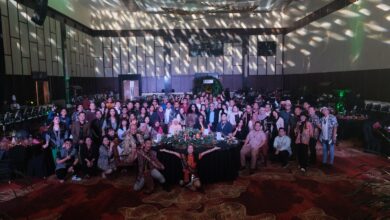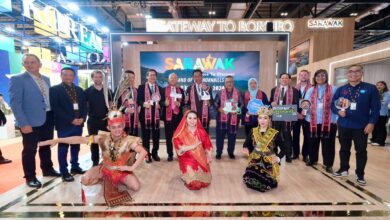Ethnicities of Sarawak
Sarawak is well-known for its cultural diversity. Malaysia’s largest state is home to at least 34 different ethnicities, with the Ibans, Chinese, Malays, Bidayuhs, Melanaus, Orang Ulus, Penans and Kayans, just to name a few.
The Ibans make up close to 30 percent of Sarawak’s population making them the largest indigenous ethnic group in the state. Ibans are known for their traditional longhouses, which hold great cultural significance in their architecture. They celebrate Gawai Dayak, a festival of thanksgiving for the bountiful harvest where traditional dances like the Ngajat are performed, and a traditional rice wine drink named ‘tuak’ is served. Sarawakian Ibans are also well known for their artistry and traditional clothing. The men dress in “sirat” with a very long loincloth around the waist, while the ladies wear the Ngepan Iban. Iban pua kumbu blankets, bark cloths, wood carvings, baskets, and ironwork pay homage to the bravery of Iban warriors and have become a popular choice for souvenirs in the tourism industry for their distinctive designs.

The Malay population constitutes approximately 25% of Sarawak’s overall population. Most Sarawakian Malays are indigenous, with some descending from native Borneo tribes and others migrating from neighboring regions like Brunei and Kalimantan. Malays were traditionally fishermen and lived around coastal areas, but over time advanced economically and are now city-dwellers. Traditionally, the men’s attire would consist of the baju Melayu, a long-sleeved shirt with a sarong accompanied by a tengkolok hat. The women wear the baju kurung, a long blouse over a sarong with a tudong to cover the head. At royal ceremonies or weddings, it is customary to perform pencak silat, a form of martial arts symbolizing liberation from foreign invasion. Wooden carvings, silver and brass craftings as well as traditional Malay textile weaving with silver and gold thread are also artistic signatures of the Malays.
The Chinese comprise of Sarawak’s third largest ethnicity. The Malayan Chinese first came to Sarawak during the Brooke era in search of employment opportunities in gold mines. Most have maintained their Chinese heritage, following traditions and superstitions during major celebrations like Chinese New Year and Mid-Autumn Festival. A highlight of Chinese celebrations are the lion and dragon dances, accompanied by distinctive rhythmic drums. The performance is considered auspicious and is believed to scare away evil spirits that could bring bad luck to a household. The Chinese are renowned for their rich artistic heritage with their intricately crafted ceramics and pottery, along with their invention of Chinese calligraphy.
The Bidayuhs mainly reside in Lundu, Bau, Penrissen, Padawan, Siburan and Serian. They have architectural wonders that are unique to their culture. An example of this is the baruk roundhouse for community gatherings and functions. It is also here where celebrations for the harvest seasons are held.
Traditional dances like the Rejang Beuh or Eagle Dance are performed in the longhouse. According to tradition, Bidayuh men would wear a long loin cloth called Tahup while women would dress in Jomuh or a short petticoat. Cylindrical carrying baskets known as tambok woven from rattan used to carry home forest produce are also a Bidayuh trademark.

The Melanaus are among the earliest settlers of Sarawak. They have their own language categorised under the North Bornean branch of Malayo-Polynesian languages. Over time, they have taken influence from Malay culture in terms of traditional clothing, religion, and lifestyle. Melanau men dress in Baban, an attire with a strong resemblance to the Malay traditional outfit, baju Melayu. The women’s attire also closely resembles the baju kurung worn by Malay ladies. This community’s rich history and livelihood along Sarawak’s seashore is portrayed by their traditional dances performed during special occasions.
Orang Ulu refers to the many diverse tribal groups who live mostly in the upriver and uphill areas of Sarawak. Orang Ulus are renowned for their artistic eye as can be seen by the elaborately decorated mural designs and wood carvings embedded on the walls of their longhouses. This is also seen in their beadwork, detailed body tattoos, and rattan weaving. To celebrate the Orang Ulu’s hunting culture, the Kanjet Ngeleput was created and performed by a male dancer in full warrior attire. This captivating dance portrays the nimble yet stealthy movements of the warrior as he goes on a hunting trip in the jungle, accompanied by the sape, a traditional Orang Ulu musical instrument.

The Penan people are a smaller ethnic group under the Orang Ulus who reside mainly in the Miri district, far east of Sarawak. Even in present time, they remain as nomad travelers in Sarawak’s dense jungles and live off produce from their hunting adventures. The Penans adorn themselves with accessories and jewelry that go on their heads, and a bracelet made from black-colored rattan. During social or cultural events, their traditional dance, Sayau Titot is performed. They are also excellent and skilled weavers, looming together basketweaves, mats, rattan bags and accessories to complement their traditional outfits.
Another smaller sub-ethnic group of the Orang Ulu’s is the Kayan group. Similar to their neighbors, the Kenyah tribe, they are grouped together with the Bahau people under the Apo Kayan people group. The Kayans are renowned for their beadwork and craftsmanship, producing wood carvings from belian wood. They are also revered for their boat making knowledge. Kayan women in particular have a distinctive feature that has drawn attention towards this tribe. Their long slender necks adorned with brass rings have given the Kayans the noniker ‘long-neck people’. This generations-old tradition stems from their belief that long necks are considered beautiful.
This unique blend of different ethnicities stands as one of Sarawak’s most important traits, where people of varying ethnicities can live harmoniously united as one. It is important to preserve these cultures and heritage to foster self-identity and social tolerance, which are essential elements in maintaining an inclusive society. Visit www.sarawaktourism.com to learn more about Sarawak’s diverse background.




